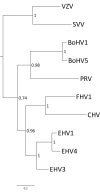Genome Sequence of Canine Herpesvirus
- PMID: 27213534
- PMCID: PMC4877106
- DOI: 10.1371/journal.pone.0156015
Genome Sequence of Canine Herpesvirus
Abstract
Canine herpesvirus is a widespread alphaherpesvirus that causes a fatal haemorrhagic disease of neonatal puppies. We have used high-throughput methods to determine the genome sequences of three viral strains (0194, V777 and V1154) isolated in the United Kingdom between 1985 and 2000. The sequences are very closely related to each other. The canine herpesvirus genome is estimated to be 125 kbp in size and consists of a unique long sequence (97.5 kbp) and a unique short sequence (7.7 kbp) that are each flanked by terminal and internal inverted repeats (38 bp and 10.0 kbp, respectively). The overall nucleotide composition is 31.6% G+C, which is the lowest among the completely sequenced alphaherpesviruses. The genome contains 76 open reading frames predicted to encode functional proteins, all of which have counterparts in other alphaherpesviruses. The availability of the sequences will facilitate future research on the diagnosis and treatment of canine herpesvirus-associated disease.
Conflict of interest statement
Figures


Similar articles
-
Gene arrangement within the unique long genome region of infectious laryngotracheitis virus is distinct from that of other alphaherpesviruses.J Virol. 1998 Jan;72(1):847-52. doi: 10.1128/JVI.72.1.847-852.1998. J Virol. 1998. PMID: 9420298 Free PMC article.
-
The DNA sequence of equine herpesvirus-1.Virology. 1992 Jul;189(1):304-16. doi: 10.1016/0042-6822(92)90706-u. Virology. 1992. PMID: 1318606
-
Primary structure of the herpesvirus saimiri genome.J Virol. 1992 Aug;66(8):5047-58. doi: 10.1128/JVI.66.8.5047-5058.1992. J Virol. 1992. PMID: 1321287 Free PMC article.
-
The DNA sequence of human herpesvirus-6: structure, coding content, and genome evolution.Virology. 1995 May 10;209(1):29-51. doi: 10.1006/viro.1995.1228. Virology. 1995. PMID: 7747482 Review.
-
Recombination in alphaherpesviruses.Rev Med Virol. 2005 Mar-Apr;15(2):89-103. doi: 10.1002/rmv.451. Rev Med Virol. 2005. PMID: 15546129 Review.
Cited by
-
Small RNA sequencing analysis reveals regulation of microRNA expression in Madin-Darby canine kidney epithelial cells infected with Canid alphaherpesvirus 1.Virus Genes. 2024 Oct;60(5):537-548. doi: 10.1007/s11262-024-02091-6. Epub 2024 Jul 17. Virus Genes. 2024. PMID: 39017941
-
Herpesviruses: overview of systematics, genomic complexity and life cycle.Virol J. 2025 May 22;22(1):155. doi: 10.1186/s12985-025-02779-7. Virol J. 2025. PMID: 40399963 Free PMC article. Review.
-
First molecular detection of canine herpesvirus 1 (CaHV-1) in the Eastern Brazilian Amazon.J Vet Sci. 2022 Mar;23(2):e18. doi: 10.4142/jvs.21202. Epub 2021 Dec 16. J Vet Sci. 2022. PMID: 35187876 Free PMC article.
-
Canid herpesvirus 1 Preferentially Infects Polarized Madin-Darby Canine Kidney Cells from the Basolateral Surface.Viruses. 2022 Jun 14;14(6):1291. doi: 10.3390/v14061291. Viruses. 2022. PMID: 35746762 Free PMC article.
-
Genomic analysis for virulence determinants in feline herpesvirus type-1 isolates.Virus Genes. 2020 Feb;56(1):49-57. doi: 10.1007/s11262-019-01718-3. Epub 2019 Nov 27. Virus Genes. 2020. PMID: 31776852 Free PMC article.
References
-
- Carmichael LE, Squire RA, Krook L. Clinical and pathologic features of a fatal viral disease of newborn pups. Am J Vet Res. 1965;26:803–14. . - PubMed
-
- Pellett PE, Davison AJ, Eberle R, Ehlers B, Hayward GS, Lacoste V, et al. Herpesviridae In: King AMQ, Adams MJ, Carstens EB, Lefkowitz EJ, editors. Virus Taxonomy, Ninth Report of the International Committee on Taxonomy of Viruses. London: Elsevier Academic Press; 2012. p. 111–22.
-
- Rota PA, Maes RK. Homology between feline herpesvirus-1 and canine herpesvirus. Arch Virol. 1990;115:139–45. . - PubMed
-
- Martina BEE, Harder TC, Osterhaus ADME. Genetic characterization of the unique short segment of Phocid herpesvirus type 1 reveals close relationships among alphaherpesviruses of hosts of the order Carnivora. J Gen Virol. 2003;84:1427–30. . - PubMed
-
- Rémond M, Sheldrick P, Lebreton F, Nardeux P, Foulon T. Gene organization in the UL region and inverted repeats of the canine herpesvirus genome. J Gen Virol. 1990;77:37–48. . - PubMed
Publication types
MeSH terms
Substances
Grants and funding
LinkOut - more resources
Full Text Sources
Other Literature Sources

